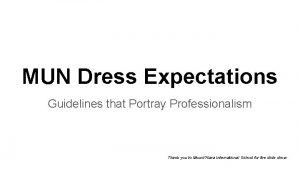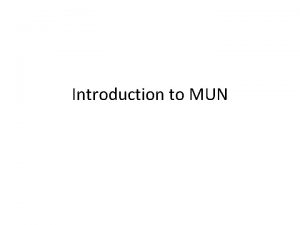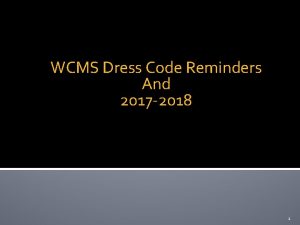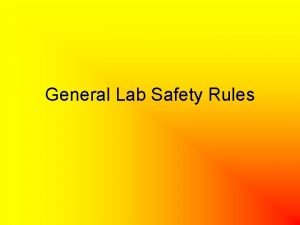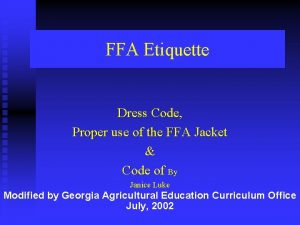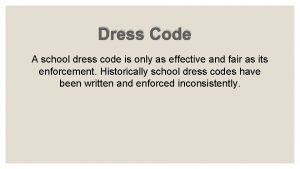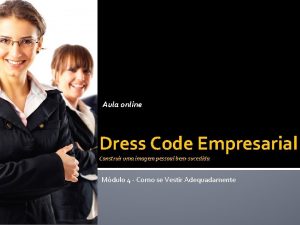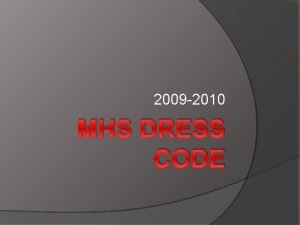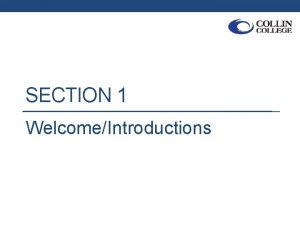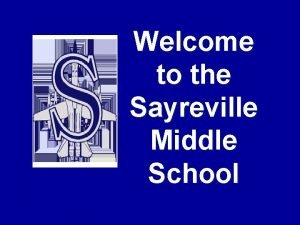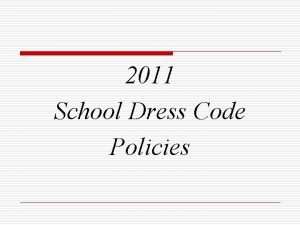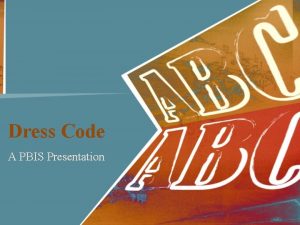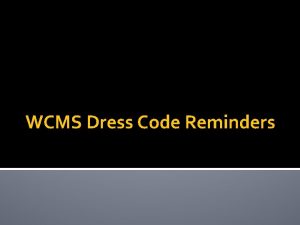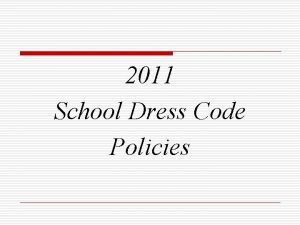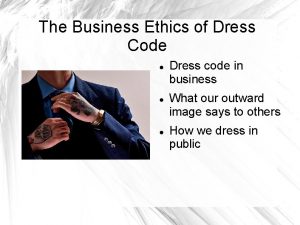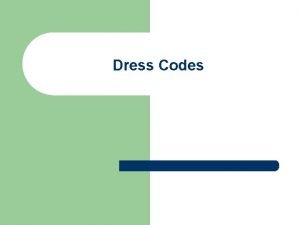Introduction to MUN Dress code As MUN is










































- Slides: 42

Introduction to MUN

Dress code • As MUN is a simulation of the United Nations, all participants are expected to dress appropriately. • This means that the dress code is formal. • Men should wear a suit and a tie. • Women should dress formally as well. This includes a dress or a skirt which will not be shorter than the knee. • Trainers and jeans are prohibited. • If participants are dressed inappropriately, they will be requested to change clothing.

Delegates • Each school is assigned a country, and then these delegates are separated into different committees. • Delegates need to research their countries and maybe create a policy statement and research the issues that will be debated. • This helps delegates debate and prepare their resolutions.

RESOLUTIONS • MUN works with resolutions to solve the problems at the agenda. • A resolution is one long sentence, divided in two kinds of clauses. • Preambulatory clauses, which give the background information to the topic • Operative clauses, which state the solution that is proposed by the resolution.

Lobbying for your resolution • Once you’ve finished writing your resolution, you have to find people who support it. • There isn’t enough time to discuss all the resolutions only the ones which get enough support before the debate are being discussed. • What you will have to do while lobbying for your resolution is find delegates who are willing to sign become co-submitters through signing your resolution. • Only resolutions with 5 co-submitters or more can get approved to be debated. • When searching for co-submitters, you can give as many people as possible a chance to read your resolution, and try to convince them to think the same about the issue. • However, since every delegate has a country to represent, and not all countries have the same opinion, this is not an efficient way to find co-submitters.

Lobbying for your resolution • Research which countries have the same opinions as yours, or of which the opinions are alike your country’s. • You can think of countries that are in the same Intergovernmental Organisations (IGO’s) as yours (for example, France will probably looking for members of the European Union, while South Africa will try to find members of the African Union, and Saudi Arabia searches for Arab League members). • Another option that should be considered is merging. • Merging your resolution with others, and giving others a say in its content, will give you a more stable base when the resolution is debated. • It also makes the lobbying process itself a lot easier, since people are a more interested in working together if you are able to compromise, and listen to their arguments and ideas.

Getting your resolution approved • The last step that has to be taken before a resolution is debatable is getting it approved. • This process can only be started if you have the signatories of 5 cosubmitters. The first step you should take is bringing the resolution to your chair or president. • He or she will check the resolution for accordance with the United Nations Charter and for plagiarism, and check whether all language is appropriate. • If changes are necessary, always be sure to consult with your cosubmitters, and make sure they know of, and agree with, the changes. • When a chair is content with the resolution, he or she signs it, and he or she will then take it to the Approval Panel. • Here, the resolution will be checked for grammar mistakes, incorrect format etc.

Getting your resolution approved • When the resolution is correctly formatted, the Approval panel will approve the resolution, and your job is done. • The administrative staff will make sure it is copied and brought to your committee, so you can speak on it in debate. When the panel finds mistakes, however, you will be handed the resolution back, and have to correct it. • After this, you once more hand in the resolution. Important: Do not only hand in the edited resolution, but also the original one. This will make sure you won’t have to go back to your chair to get another signatory, and will speed up the approval process. • This step (editing the resolution) can be done multiple times, until the resolution is in correct form.

COURSE OF DEBATE

A session of a committee will have the following structure 1. 2. 3. 4. 5. 6. Opening by the chair or president Roll call Drawing up the agenda Reading the operative clauses of the resolution out loud (usually by the main submitter) Chair or president sets a debate time (closed or open debate) Debate time on the resolution: speeches, points, motions and amendments can be made. Voting on the resolution Repeating the points 4 to 7 if more than one resolution is to be discussed Closing by the chair or president

Formalities • Always speak in the third person- never refer to yourself as I, but rather as “the delegate of…” • When stating a point of information stand when asking your question and remain standing while your question is being answer. • You can’t make a retort to the answer, but you can ask the chair for a follow up • If you are making a speech start off with: Honourable Chair, fellow delegates. • After you have made your speech the chair will ask if you want to put yourself to any points of information. If you want to answer them all say “any and all” If you only want to answer a certain amount, state the number you wish to answer. Of course you can also not answer any points of information

Roll call At the beginning of each session, immediately after the opening, the chair will hold a roll call. He or she calls out all delegations that should be present in the forum and every delegate replies by shouting ‘present’, and raising his or her placard.

Open and closed debate • After the operative clauses of the resolution have been read out, the chair sets the debate time on the resolution. • When a speech is held or a question is answered, this time is running. When a point or motion is dealt with, as well as when an amendment is discussed, the clock is paused. • Debate time can be an open or a closed debate. • Open debate means that every delegate can request the floor and make a speech, regardless of their opinion on the issue. • In closed debate, delegates in favour of the resolution can first speak in time in favour, and delegates opposing the resolution can state their concerns after that, in time against.

Speeches • At the beginning of the debate on a resolution, the chair will give the floor to the main submitter. • After this, the speaker can open him- or herself to points of information • When a speaker is no longer open to points of information, or when there are no points in the house, he or she yields the floor. • Usually, the floor is yielded to the chair, so the chair can open it again for other delegates to speak.

Speeches • The speaker can also yield the floor to another delegation, but this can only be done once consecutively. • So speaker A can yield the floor to speaker B, but after his speech, speaker B cannot yield the floor to speaker C, or back to speaker A. He or she will have to yield the floor to the chair. • When addressing each other or the chair, delegates should use third person, so: “Does the delegate agree with us that…” instead of “Do you agree with us that…”, and “Could the chair please explain…” instead of “Could you please explain…. ” • Also, speakers should try to abstain from using unparliamentarily or abusive language.

1) Policy statement/seech • Sometimes debate can ask for policy statements on the issue. • A policy statement is a short speech stating your country’s opinion on the matter. • A policy statement can be written on a single topic, or at all the topics on the agenda of one forum. • The speech should not exceed one minute.

2) Opening speech • This speech is held at the opening of the General Assembly, by the ambassador of a delegation. • The speech has a time limit of one minute, and can be about almost everything; the intentions of the delegation at the conference, one or more of the issues on the agenda or a recent development in the region of your country are just a few options. • It is not obligatory to make an opening speech: ambassadors will be asked whether or not they prefer to make one. • No delegation can make more than one speech.

2) Opening speech • It is possible to make a joined opening speech. This means one delegate makes a speech in name of multiple delegations. For example, when Denmark, Luxembourg, Norway Sweden and The Netherlands want to say somewhat the same thing, they can appoint one of the ambassadors, say Sweden, to make an opening speech. The time limits of the speeches will then be combined, so that he or she can hold a speech of 5 minutes.

3) Right of reply • The right of reply isn’t exactly a speech, but a statement following to the Opening Speech. • After a fixed number of speeches, the President will entertain a few rights of reply. • Every delegate can then ask the floor for a maximum of 30 seconds, to reply to one of the given speeches.

Amendments • Amendments are proposed alterations to the resolution. • With one amendment you can add, replace or strike (a part of) one clause. • Every amendment can only alter one clause at the most. • Once a clause has been amended, no other amendment can be made concerning the same part of the clause. • For example, if an amendment passes to replace (sub-) clause 5 b, after that, alterations can only be made to (sub-) clauses 5 a, c, etc. , and not to the new sub-clause b.

Amendments • If you want to propose an amendment, raise your hand. • The administrative staff will then bring you an amendment sheet, on which you write down your proposal. • You then submit your amendment by sending it to the chair, like you normally do with a note. • Once the chair receives the amendment, he or she will check if it is in order. You can then take the floor and officially propose your amendment, by saying “The delegate has proposed/submitted an amendment”. • The chair will now read out the amendment aloud, so the house can write it down. • After that, the chair sets a debate time on the amendment (during this time, the time on the resolution does not run), usually closed debate, and gives the floor to the submitter of the amendment.

Amendments • Once debate time on the amendment has elapsed, the chair will propose to move into voting procedures. • When voting on an amendment, delegates are only allowed to vote in favour or against the amendment, abstentions are out of order. • Besides this, voting is done in the same way as voting on a resolution (see ‘voting’ below).

Amendments • It is also possible to propose an amendment to the amendment (Also known as an amendment of the second degree). • This amendment has to be submitted before voting on the original amendment takes place, and follows the same rules as a normal amendment. • An amendment to the amendment can not be altered, so there is no such thing as an amendment of the third degree, or an amendment to the amendment.

Amendments • Once voting on an amendment to the amendment has taken place, the debate on the amendment will be resumed, except in the case where the amendment to the amendment has altered the amendment in total. • For example: when an amendments states to add “within a month from the environmental disaster” to a certain clause, and the amendment states to change it into “within two years from the environmental disaster”, a vote in favour of the amendment to the amendment will make that there will not be another vote on the amendment.

Points • Points are questions asked during debate, to a speaker or the chair. • No point may ever interrupt a speaker, except for a point of personal privilege when concerning audibility. • When you make a point, you shout (for example) “Point of information to the chair”, and raise your placard. • The chair will then recognise you. • You are expected to stand up when you make a point, and remain standing while the point is being answered. • When a point is made, objections and seconds are out of order.

Points (of personal privilege ) • Point of personal privilege concerns your personal well-being. • Most of the time, this point is made when somebody can’t hear what is being said. • When indeed referring to audibility, the point may interrupt a speaker. • But when the point is referring to anything else discomforting, such as the temperature in the room, it cannot.

Points (of information to the speaker) • Point of information to the speaker • This is a question to the speaker, when a speech has ended. • Every speaker has the choice to open him- or herself to such points. • Also, the chair may set a limit to the number of points when debate time is limited. • Since the chair will normally ask if there any points, you will only have to raise your placard, and not yell out ‘Point of information’. • A point of information can exist of only one question at a time. Follow-ups are allowed at the chair’s discretion, but should relate to the original question.

Points (of information to the chair) Used to ask the chair a question concerning the debate, such as: “how much debate time is left on this resolution? ”

Points (of order) • When a delegate feels the rules of procedure are not maintained, he or she can raise a point of order. • This can be done when one feels insulted by a speech or point of another delegate, or when he or she feels the chair makes a mistake in the course of debate.

Points (of parliamentary inquiry) • This point is a point of information to the chair, related to the rules of procedure. • A question can vary from what closed debate is, to how an amendment is submitted.

Motions • Motions usually are a request concerning the course of debate. • When you make a motion, you yell, for example, “Motion to extend debate time”, and raise your placard. • A motion may never interrupt a speaker. • Since a motion is not a question, but a request, it is debatable. Therefore, a motion will only be entertained if there is at least one second and no objections. • Some more complicated motions ask for debate, and need a majority or even a two-thirds majority to pass.

Motion to extend debate time • When debate time has elapsed, but someone feels that more time is needed to discuss the resolution, amendment or motion, he or she can call for this motion. • It needs a second and no objections, but in the end, the chair may decide if the motion is entertained.

Motion to move into voting procedures • This motion can be used when debate time has not yet elapsed, but you feel that everything that needs to be considered is debated.

Motion to refer a resolution/question to another forum • The chair may start a debate on this motion. When direct action is taken, a resolution can not be passed in a committee, but should either be changed, or send to the Security Council. • When the forum feels the issue can not be solved without direct action, the whole issue will be assigned to the Security Council. • Because the Council already has its own issues to discuss, this usually means the issue will no longer be discussed.

Motion to divide the house • This motion can be called when votes have been taken and counted, and the result is a very close vote. • It is entertained very seldom, because of the large amount of time it takes. • When entertained, the chair will ask every delegate to state their vote, so that the votes can be counted carefully.

Motion to reconsider a resolution • Meaning to re-debate a resolution that has already been passed. • This can only be done if no other resolutions need to be discussed on the topic, and when two thirds of the house is in favour.

Motion to table a resolution • When this motion passes, debate on the resolution will cease immediately. • The resolution can be reconsidered after all other business is dealt with. • Due to lack of time, this usually means the resolution will not be discussed anymore.

Motion to take a resolution from the table • Asks for the reconsidering of a resolution that has been tabled. • This can only be done when all other resolutions have been discussed, and the motion needs a two-thirds majority to pass.

Motion to appeal from the decision of the chair • A very rarely used motion, which refers to the last decision of the chair. • It can only be used right after the decision is made, and will not result in a debate. • It needs a two-thirds majority. • When the motion is passed, the decision which the motion refers to will be reversed.

Objection to the main motion • Another rarely used motion, which needs a twothirds majority to pass. • It states a delegate’s objection to the resolution that is debated. • The delegate raising this motion will be entertained one minute to explain his or her objections, after which the forum will move into voting procedures. • Entertaining this motion means the resolution will not be further debated.

Voting • Once the debate time on a resolution has elapsed, the chair will normally propose to move into voting procedures. • On a resolution, delegates may vote in favour or against the resolution, or abstain from voting. • Votes are taken by counting placards. • The chair will ask all delegates in favour of the resolution to raise their placards, then all delegates against, and after that all delegates abstaining. • Abstentions will not be counted in the balance, and a resolution will pass when there are more votes in favour than against (so a tied vote fails).

Note passing • During the debate, delegates can send notes to each other. • The chair can suspend note passing for some time, for example during the speech of a guest speaker, and during voting procedures. • Every delegation should have its own official notepaper, on which the delegation is clearly named. • Also, on the outside of every note (you normally fold your note once or twice), the delegation to whom the note is addressed should clearly be written.
 Mun dress code
Mun dress code Introduction to mun
Introduction to mun Code commit code build code deploy
Code commit code build code deploy Mayo clinic dress code
Mayo clinic dress code Carver middle school uniforms
Carver middle school uniforms Dress code reminders
Dress code reminders Fccla dress code
Fccla dress code 2004 dress code
2004 dress code Bpa dress code
Bpa dress code Does jones college prep wear uniform
Does jones college prep wear uniform Dse 覆 核 成功 率
Dse 覆 核 成功 率 Dress code lab
Dress code lab Ffa creed definition
Ffa creed definition 3 inappropriate dress items for fbla
3 inappropriate dress items for fbla Dutchtown high school uniform policy
Dutchtown high school uniform policy Dress and appearance in communication
Dress and appearance in communication Hcps dress code
Hcps dress code Efy dress standards
Efy dress standards Dhs prom
Dhs prom Azalea middle school dress code
Azalea middle school dress code Azalea middle school dress code
Azalea middle school dress code Manual de dress code empresarial
Manual de dress code empresarial Auburndale high school dress code
Auburndale high school dress code 2009 dress code
2009 dress code Collin college dress code
Collin college dress code Bpa dress code
Bpa dress code Asu prep parent portal
Asu prep parent portal Fbla mission statement
Fbla mission statement Jrotc dress code
Jrotc dress code Bethlehem dress code
Bethlehem dress code Wlhs dress code
Wlhs dress code Weddington middle school dress code
Weddington middle school dress code Oncourse sayreville
Oncourse sayreville Lcsid skyward
Lcsid skyward Papa murphy's uniform
Papa murphy's uniform Hhihs dress code
Hhihs dress code E.o green dress code
E.o green dress code Barro's pizza near me
Barro's pizza near me Mens viking clothing
Mens viking clothing Tutor dress code
Tutor dress code John marshall middle school
John marshall middle school Deca dress code
Deca dress code Bpa dress code
Bpa dress code
